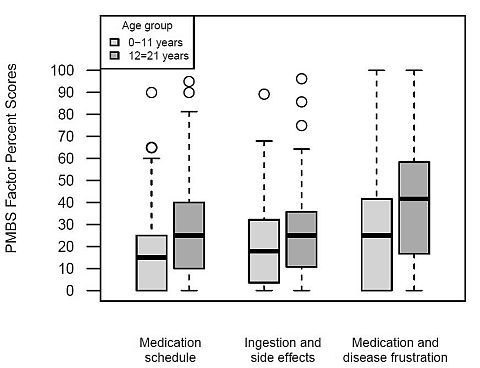Perceived Barriers to Adherence in Pediatric Transplantation from the Guardian’s Perspective
Cincinnati Children's, Cincinnati
Cleveland Clinic, Cleveland
NIAID/NIH, Bethesda
Washington University, St. Louis
Meeting: 2013 American Transplant Congress
Abstract number: 255
Adolescents have increased non-adherence risk. Comparisons of perceived barriers to adherence in pediatric and adolescent solid organ transplant recipients (SOT) have not been conducted.
15 US centers in the Clinical Trials in Organ Transplantation in Children enrolled 442 SOT recipients in a cross-sectional study. Parent Medication Barriers Scale (PMBS) was completed by a guardian along with demographics. After measurement models indicated that the 3 PMBS factors were measuring similar constructs across age groups, unadjusted analysis and propensity-adjusted analyses of age on PMBS factors were performed.
Results: 384 completed the PMBS; 59% male and 45% had only governmental insurance. The majority received a kidney(46%); the remainder were heart(25%), liver(20%) and lung(8%). 190 young(0-11y; mean 5.6y) and 194 older(12-21y; mean 15.3y) were compared. Older recipients had longer time since transplant (52.1(SD=57.7) months vs.30.1(SD=32.7)). PMBS questions mapped to 3 primary factors, med scheduling, ingestion problems/side effects, and medication/disease frustration. Both unadjusted(Fig1) and propensity-adjusted analyses revealed statistically significantly increased perceived barriers to adherence in the older group. Both analyses indicated more substantial differences in the medication/diseases frustration and scheduling domains(p<0.05). Sub-group analyses showed that age differences remained across organ type and insurance status.

Conclusion: With PMBS after pediatric SOT, guardians of older patients report increased perceived barriers to adherence, especially with regard to organizational and time challenges (med scheduling) as well as the emotional impact of chronic disease (medication/disease frustration). Both groups perceived similar, significant barriers related to the regimen itself (pill number/side effects). Interventions designed to enhance organizational skills and address the emotional component may be particularly important for maintaining adherence in adolescent SOT recipients.
To cite this abstract in AMA style:
Danziger-Isakov L, Frazier T, Worley S, Williams N, Bridges N, Sweet S, Consortium CTOTC-05. Perceived Barriers to Adherence in Pediatric Transplantation from the Guardian’s Perspective [abstract]. Am J Transplant. 2013; 13 (suppl 5). https://atcmeetingabstracts.com/abstract/perceived-barriers-to-adherence-in-pediatric-transplantation-from-the-guardians-perspective/. Accessed July 5, 2025.« Back to 2013 American Transplant Congress
